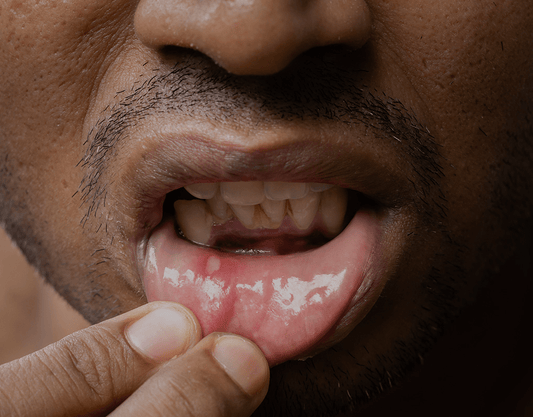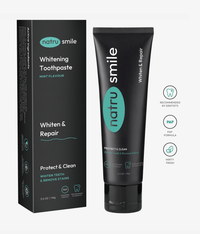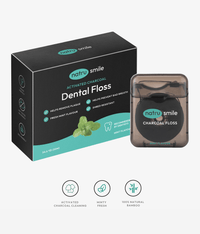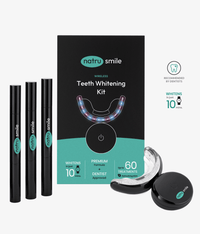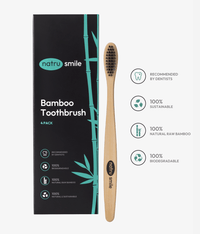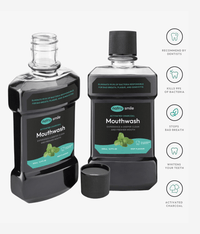
All products are certified by dental expert Dr. Greg Grillo
Like all aspects of your oral health, your gums are nothing to play around with. And white spots in an area where any color change is out of the ordinary could be cause for concern.
If you have white spots on your gums, the good news is that it might not be a sign of something serious. Some might just be caused by poor oral hygiene, while others may indicate an underlying health condition or infection.
Still, understanding the root causes and how to treat them goes a long way when it comes to protecting your oral health.
In this article, we'll tell you everything you need to know about white spots on gums and how to improve your smile if you have them.
What Are These White Spots On My Gums?
If you find yourself asking this question, you’re not alone. White spots on the gums are somewhat common and can range from small patches to large areas of discoloration.
Unlike white spots on teeth, which are sometimes caused by enamel hypoplasia, fluorosis, or white spots after whitening, the causes of gum spots can be more serious.
White spots on the gums are most commonly caused by canker sores, which are small, painful sores that usually appear on the inside of your cheeks. But they can also form on your gums, tongue, and lips.
They can also form due to a condition called leukoplakia, which is associated with the overgrowth of the outer layer of gum tissue. This overgrowth can form patches on the gums, which appear as white spots.
Other possible causes include Candida albicans (thrush) infections and other inflammatory conditions in the mouth.
Treatment for white spots depends on the underlying cause and may involve antibiotics, antifungal medications, or topical treatments.
Common Causes Of White Spots On Gums
White spots on the gums can have a variety of causes. Some are harmless, but others may signal an underlying health problem or infection.
Common causes include:
1. Poor Dental Hygiene
Brushing and flossing your teeth twice a day are the most effective ways to protect against plaque accumulation and bacterial buildup in your mouth. If left unchecked, these bacteria can result in an infection that could create white spots on the gums.
It can also cause a host of other problems, like white spots on teeth from cavities, bad breath, and gum disease.
To ensure that your teeth and gums stay healthy, take the following measures:
- Brush your teeth twice per day with a fluoride mouthwash
- Floss every day
- Visit your dentist for regular check-ups and dental cleanings
- Use mouthwash for additional protection
- If you follow a regular oral care routine, many of your oral health problems—including some causes of white spots on gums—will go away on their own or be avoided altogether.
2. Canker Sores
Canker sores are small, shallow lesions that form inside the mouth on the cheeks, gums, tongue, or palate. They usually appear as white spots on the gums and can be caused by stress, hormonal changes, and nutritional deficiencies.
These small yet frustrating sores impact about one-fourth of the population, making them the most common reason for white spots on your gums. They can range from minor to severe in terms of pain and discomfort.
Treatment for canker sores includes avoiding irritants (e.g., spicy foods, citrus fruits, and other foods that damage teeth), eating soft foods, and taking over-the-counter medications to reduce pain and inflammation.
If symptoms persist, it’s best to visit your dentist or doctor for an accurate diagnosis and treatment options.
3. Candida Albicans (Thrush)
Thrush is a common infection caused by the yeast Candida albicans. It can cause white patches on the gums, tongue, and inner cheeks that may be itchy or painful.
Common causes of thrush include:
- Taking antibiotics
- Uncontrolled diabetes
- A weakened immune system
Typically, thrush feels like a burning sensation in the mouth and can cause bad breath and difficulty swallowing. In some cases, the infection can spread to nearby parts of the body like the esophagus.
Treatment for thrush usually involves antifungal medications taken orally or applied topically. Common medications include nystatin, clotrimazole, and fluconazole.
4. Lichen Planus
Lichen planus is a chronic, inflammatory skin condition that can cause white spots on the gums and mucous membranes. It’s believed to be caused by an immune system malfunction that leads to the production of inflammatory cells and proteins.
It occurs when the body’s immune system mistakenly attacks healthy cells in the mouth, causing an antibody-induced reaction that results in an irritation of the tissue.
The white spots are usually rough and scaly to the touch and may be accompanied by redness and swelling.
In some cases, lichen planus can cause painful ulcers in the mouth because of the irritation it causes.
Treatment for lichen planus usually involves topical medications and mouthwashes to reduce inflammation and pain. In severe cases, systemic drugs may be prescribed.
5. Leukoplakia
Leukoplakia is a condition caused by the buildup of white patches on the outer layer of gum tissue. These patches are typically caused by irritation, such as from tobacco use or dentures, and can cause pain and discomfort if left untreated.
Common causes of leukoplakia include:
- Tobacco use
- Consistently poor dental hygiene
- Dentures that don't fit properly
The condition does not usually spread to other parts of the body but may become cancerous in some cases. Between 3 and 17.5 percent of leukoplakia cases turn into cancer within 15 years, making it different from others.
Treatment for leukoplakia includes lifestyle changes such as quitting smoking, avoiding irritants, and taking medications to reduce inflammation.
If symptoms persist, it’s crucial to speak with your dentist for an accurate diagnosis and appropriate treatment plan, as leukoplakia can be more serious than other causes of white spots on your gums.
White Spots On Gums: What To Look Out For (Pictures)
Canker sore on the lower lip.
Candida albicans (thrush) on the upper area of the gums and lip.
Serious oral lichen planus behind the teeth.
Oral leukoplakia on the bottom of the mouth.
Symptoms Of White Spots On Gums
Like all oral health conditions, white spots on gums can range from mild to severe. It’s important to keep an eye out for the following symptoms:
Red Or Inflamed Gums
There are several reasons your gums may be inflamed:
- Poor oral hygiene
- Over-brushing your teeth or brushing too roughly
- Injury to the gums (e.g., from aggressive flossing or biting down too hard)
- Recent teeth whitening sessions
- Gingivitis
- Periodontitis (gum disease)
- Canker sores or ulcers
Inflammation is a reaction to an irritant, and the redness and swelling can be accompanied by pain or tenderness.
Whatever the cause of your white patches, inflammation may result as your body attempts to combat the irritant.
Yellow Or White Gums With A Small Red Border
If a portion of your gums is yellow or white with a thin red ring, you probably have a canker sore. These small white or yellow spots are often accompanied by redness, tenderness, and swelling.
If you're unlucky, a canker sore might occur in a spot that's particularly difficult to manage. For example, a sore between two of your back teeth can be much more painful or uncomfortable than a sore on the side of your cheek.
Canker sores usually occur on their own but can be caused by certain foods, poor hygiene, and other oral health issues. Stress is an indicator of oral health that can also cause canker sores—if you’re feeling stressed or overwhelmed, that could be the root cause of the white spots on your gums.
In general, canker sores aren't anything to worry about. Since they're so common, you don't usually need to take any special measures. However, if your canker sores are recurring or unusually large, it's best to see a dentist for an evaluation and diagnosis.
Pain When Eating And Drinking
When eating or drinking, inflamed or irritated gums might be painful. Certain foods and drinks can exacerbate this issue, including:
- Citrus fruits like lemons, limes, and grapefruits
- Spicy foods and sauces
- Carbonated drinks such as soda, energy drinks, and sparkling water
- Alcoholic beverages with high sugar or acid content
- Ice-cold or hot food and beverages
If your white spots are accompanied by pain when eating, you can avoid certain foods until the pain subsides, or you can see a dentist for an evaluation and diagnosis.
You should also avoid intensive treatments like laser teeth whitening and bleaching if you have white spots on your gums. The benefits of white teeth can wait until the pain from these conditions subsides.
Difficulty Swallowing Or Speaking
If the white spots on your teeth are the result of leukoplakia, you might have difficulty swallowing or speaking.
And if your white spots are the result of thrush, the redness and soreness may be significant enough to cause difficulty speaking, swallowing, and breathing.
If the white spots are covering a large area of your gums, they can interfere with chewing and speaking. In some cases, the condition may even cause slurring or lisping when speaking.
These side effects are less common and typically result from serious conditions, meaning they might require medication to correct.
Bad Breath
Bad breath is a common side effect of everything from black dots on teeth to white spots on your gums. If there is an infection, decaying, or imbalance in your mouth, it will generally give off a foul odor.
Unfortunately, bad breath can also be caused by smoking, poor oral hygiene, and certain foods or drinks. This means that even if your white spots aren’t the result of an infection or decay, you may still experience a bad odor coming from your mouth if you smoke or don't brush your teeth.
If you suspect your bad breath is coming from something besides white spots on gums, give some thought to how well you clean and maintain your teeth.
Loss Of Taste
Thrush has many side effects. And since it grows on your tongue, its presence can affect your ability to taste food properly.
If you have white spots on your gums, as well as a loss of taste, it’s likely that thrush is the culprit.
Other oral problems that cause a loss of taste in your mouth include gum disease, dry mouth, and canker sores, so it's one of the most common side effects associated with white spots on gums.
Pain Under Dentures
If you wear dentures, you may experience pain under the plate caused by white spots on gums. This is because the dentures are rubbing against the affected area and irritating it.
Even if you have black gums around your teeth (i.e., dead tissue) as a result of bone loss and subsequent denture fitting, they can still be sensitive to pressure.
If you’re wearing dentures, you should get them adjusted by a dental professional to ensure the fit is comfortable and secure, especially if you've had them for some time and the white spots on your gums have developed.
Cracking Or Bleeding At The Corners Of The Mouth
Cracking or bleeding at your mouth's corners can be the result of numerous environmental or medical factors:
- Dry mouth
- Dehydration
- Cold sores
- Dry outside air
- Exposure to sun, wind, or cold
- Allergic reaction
But if you also have white spots on your gums, your cracked mouth and lips are probably a result of thrush.
Sometimes, the fungal infection spreads to other parts of the mouth, such as the corners. In this case, you’ll need an antifungal medication to treat it and stop it from spreading further.
Proven Treatment Options For White Spots On Gums
The exact treatment that will work for you depends on the exact cause and severity of your white spots. In general, however, there are some proven treatment options that you can consider:
- Antifungal medications to treat thrush or other fungal infections
- Anti-inflammatory medications for gum disease
- Topical treatments such as creams, gels, and pastes to reduce inflammation or irritation from the white spots
- Surgery to remove dead or infected tissue
- Medicated mouthwashes to reduce inflammation and prevent the spread of infection
- Laser treatments to remove the affected tissue
- Teeth whitening to reverse residual damage caused by the infection
- Saltwater or baking soda rinse to ease the pain of canker sores
- Good oral hygiene to prevent future infection, including brushing twice daily and flossing after meals
In most cases, these procedures aren't painful, although some may cause temporary discomfort.
6 Ways To Prevent White Spots On Gums
It’s important to remember that prevention is always better than cure. Taking good care of your teeth, gums, and mouth can help keep white spots from appearing in the first place.
Here are five tips to help you prevent white spots on your gums:
1. Visit Your Dentist Regularly.
Visiting your dentist every six months is essential if you want to maintain good oral health. Your dentist will be able to spot any early signs of white spots or other issues and recommend treatment before they become more serious.
If you have any other oral health concerns, such as getting rid of white spots on teeth, managing gum disease, or preventing cavities, you can use your in-office visits as opportunities to voice your concerns as well.
2. Brush Your Teeth After Meals.
The dental and medical communities agree that brushing twice per day is essential for good oral hygiene. But some research points to brushing three or more times per day as a way of lowering your risk of heart failure, stroke, and detrimental oral health problems.
Brushing your teeth after every meal is an excellent way to remove any food particles that may have been left behind, as well as reduce plaque buildup and prevent the spread of infection.
If you brush your teeth immediately following a meal with acidic elements, however, the enamel layer covering your tooth will be damaged. To allow for this damage to heal and rebuild itself, wait no less than 30 minutes prior to brushing your teeth.
In doing so, you will give time for the tooth's layers to re-mineralize and recover from any potential harm that has been caused by consuming something too sour or acidic.
3. Use Mouthwash Twice Per Day.
Mouthwash is the perfect way to freshen your breath and clean your mouth in the middle of the day. And since it's a liquid, it can dislodge food particles and bacteria that may have been left behind after brushing and flossing.
If you have white spots on your gums, an alcohol mouthwash might be too harsh for your mouth and can make the spots worse. If this is the case, opt for a milder, alcohol-free version instead.
4. Eat The Right Foods.
There are many foods and drinks that damage teeth, including candy, soda, and coffee. Eating too much of these can alter the balance of bacteria in your mouth and increase your risk of developing canker sores as well as worse forms of white spots on gums.
Of course, you might not be able to avoid acidic, sugary, or starchy goods all the time. But it’s important to limit your consumption as much as possible. Instead, opt for an array of healthier foods for your teeth like whole fruits and vegetables.
5. Quit Smoking.
Smoking is a major factor when it comes to the development of white spots on gums, and it's among the most heavily studied. Nicotine can limit the flow of blood to your gum line, leading to tissue death, and even cause inflammation in your mouth that might make the spots worse.
Smoking while pregnant can even cause white spots on children's teeth, as well as other conditions like gum recession and tooth decay.
In extreme cases, smoking can cause mouth cancer, making it extremely important to kick the habit if you're a smoker.
6. Curb Your Alcohol Use.
Heavy alcohol intake is directly linked to Candida overgrowth in the mouth (among other places). This means that it directly impacts your risk of developing white spots on your gums.
Beyond white spots, alcohol consumption can cause tooth decay and other oral health issues. And those who drink a lot tend to forgo their daily oral health routines.
7. Be Aware Of Any Medications You Take.
Some medicines and prescription treatments, such as chemotherapy drugs, antibiotics, blood pressure medication, and birth control pills, are known to cause side effects like dry mouth and weaken your immune system, leaving your body vulnerable to infection and white spots on your gums.
If you’re taking any medications, discuss the potential side effects with your healthcare provider or dentist to be aware of any changes in your oral health.
Want to learn more? Here are the questions our customers frequently ask us.
Why Do I Have White Spots On My Gum Above The Tooth?
There are several causes for white spots on your forward-facing gums:
- Poor dental hygiene
- Consuming acidic foods or drinks
- Smoking or using other tobacco products
- Taking certain medications
Usually, these spots are just canker sores. But they can also be a sign of infection (e.g., thrush, lichen planus) or oral cancer, so it's important to visit your dentist for a full evaluation if your white spots are persistent or serious.
Why Do I Have White Spots On My Gum Under The Tooth?
Canker sores are usually the root cause of white spots on the gums under your teeth. They’re a common oral health issue that can be caused by anything from poor oral hygiene to genetics or even stress.
Sometimes, however, white spots can also signal other conditions like lichen planus and leukoplakia, so it's important to visit your dentist for further evaluation if your white spots are persistent, painful, or grow into white areas or lines.
Can Stress Cause White Spots On Gums?
Stress and oral health go hand-in-hand. Since stress weakens your immune system, it can leave you more vulnerable to infection (e.g., thrush, lichen planus, etc.) or canker sores, which are the most common cause of white spots on gums.
It can also cause inflammation in the mouth, which may lead to other issues like gum recession and tooth decay.
Can Healthy Gums Have White Spots?
Even if your gums are healthy, you may get canker sores every now and then.
These are common, and although painful, they're harmless. They usually go away on their own, but if you experience persistent white spots or they cause pain or discomfort, it’s best to visit your dentist for a full evaluation.
Do White Spots On Gums Go Away?
If the cause of your white spots is canker sores, they’ll usually go away on their own. However, if an infection or other condition causes your white spots, your dentist may prescribe medication, such as antifungal drugs. In either case, white spots usually go away eventually.
Does Gingivitis Cause White Spots On Gums?
Gingivitis doesn't necessarily cause white spots, but it can make your gums more vulnerable to infection and other conditions like lichen planus, which can, in turn, cause white spots. If you have gingivitis, you should take additional measures to protect your gums from further harm and infection.
What Are Small White Spots In The Mouth?
Small white spots in the mouth are called canker sores and are usually harmless. They can be caused by anything from poor oral hygiene to genetics or even stress. Usually, they go away on their own, but if you have persistent white spots or they cause pain or discomfort, they might be a sign of infection.
What Are The White Spots On My Gums After Brushing Too Hard?
If you brush too hard or use a toothbrush with hard bristles, you could be causing tiny cuts to your gums. These can result in small lacerations or canker sores, which can lead to white spots. To prevent this issue, make sure you use a soft-bristled toothbrush and brush gently.
Final Thoughts
White spots on gums can be the result of a variety of factors, including poor oral hygiene, smoking or using tobacco products, consuming acidic foods or drinks, and even stress.
Although they can be disconcerting, most white spots on gums are just canker sores, which usually go away on their own. However, if your white spots are persistent or serious, it's best to visit your dentist for further evaluation and treatment.
By following good oral hygiene habits and avoiding activities that could harm your gums (e.g., smoking, brushing too hard, etc.), you’ll be able to reduce your risk of developing white spots on your gums.

